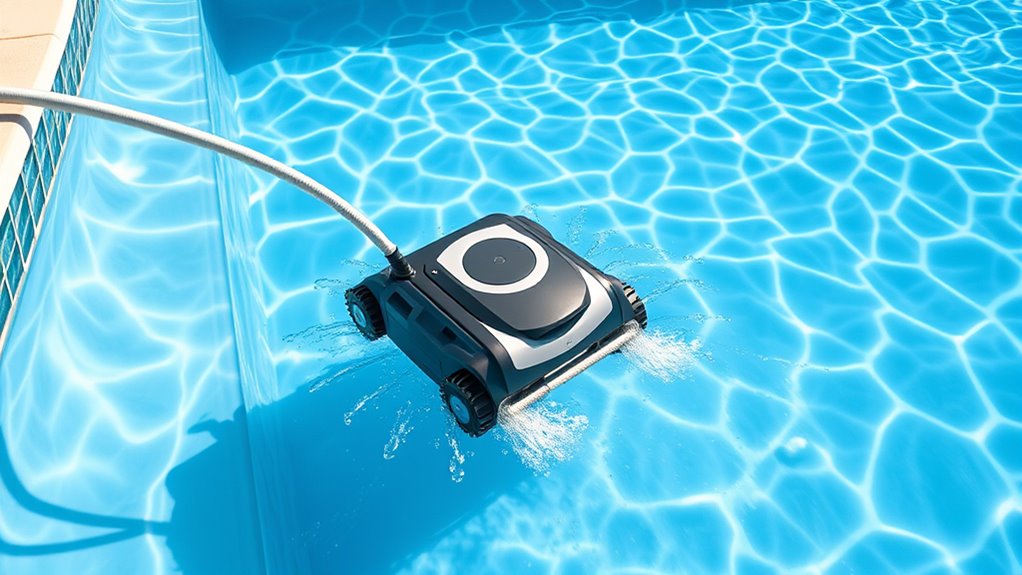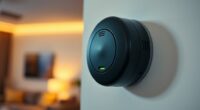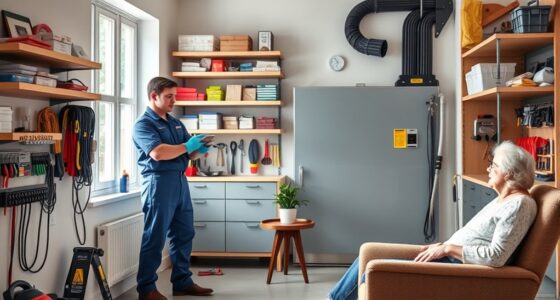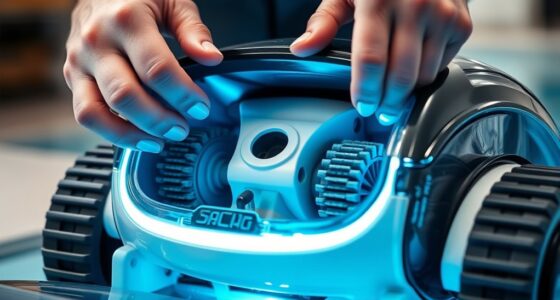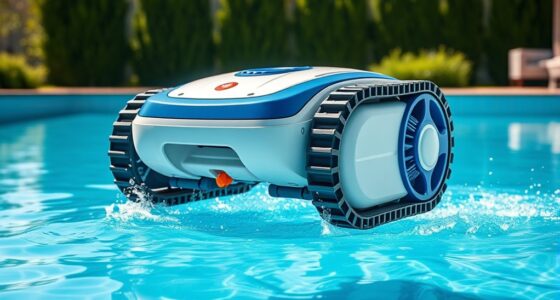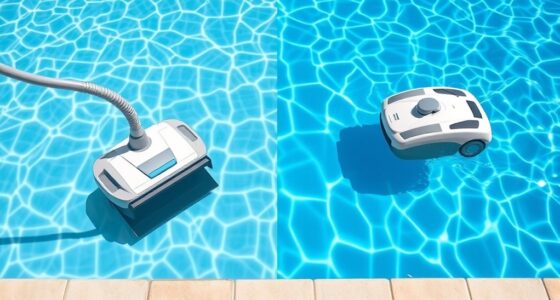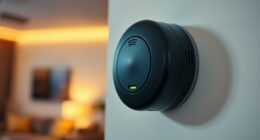Pressure pool cleaners work by using water pressure and powerful motors to remove debris from your pool. They connect to your pool’s return jet, using water flow to propel themselves and navigate around obstacles. The cleaner’s suction picks up dirt, leaves, and insects, trapping them in filters or debris baskets. These cleaners cover large areas efficiently and are low-maintenance. Keep exploring to understand how their design and features make pool cleaning easier for you.
Key Takeaways
- Water pressure powers the cleaner’s motor, creating suction that lifts debris from pool surfaces into the filter system.
- The pressure hose and booster pump supply high-pressure water to propel the cleaning head and facilitate movement.
- Sensors and navigation algorithms detect obstacles and guide the cleaner along efficient paths across the pool.
- Debris and dirt are collected in a debris basket or filter, preventing clogs and maintaining suction efficiency.
- Proper water chemistry and regular maintenance of hoses and filters ensure optimal cleaning performance.
The Basic Design and Components of Pressure Pool Cleaners
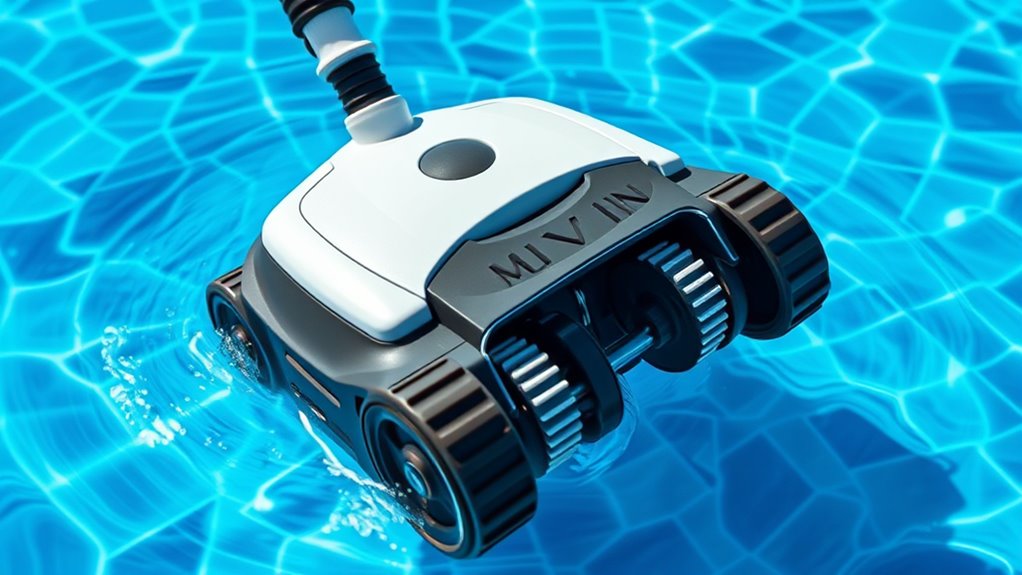
Pressure pool cleaners are designed with several key components that work together to keep your pool spotless. They typically include a pressure hose, a booster pump, and a cleaning head with jets that direct water to propel the cleaner across the pool surface. These cleaners rely on proper water pressure to operate efficiently, so maintaining correct pool chemical balance is crucial for ideal flow and performance. Ensuring the pool’s chemicals are balanced helps prevent algae buildup and keeps the water clear, which in turn supports the cleaner’s effectiveness. Additionally, following pool safety tips, such as turning off the pump before servicing the cleaner, helps prevent accidents. Understanding these components and practices ensures your pressure cleaner functions properly and keeps your pool safe and clean. Using high-quality portable pool cleaning equipment can further enhance the overall efficiency and ease of maintenance. Proper maintenance of water circulation systems also plays a vital role in keeping your pressure cleaner working at optimal levels. Regular inspection of pressure hoses and fittings can help identify potential leaks or blockages that may reduce performance.
How Water Pressure Powers the Cleaning Process
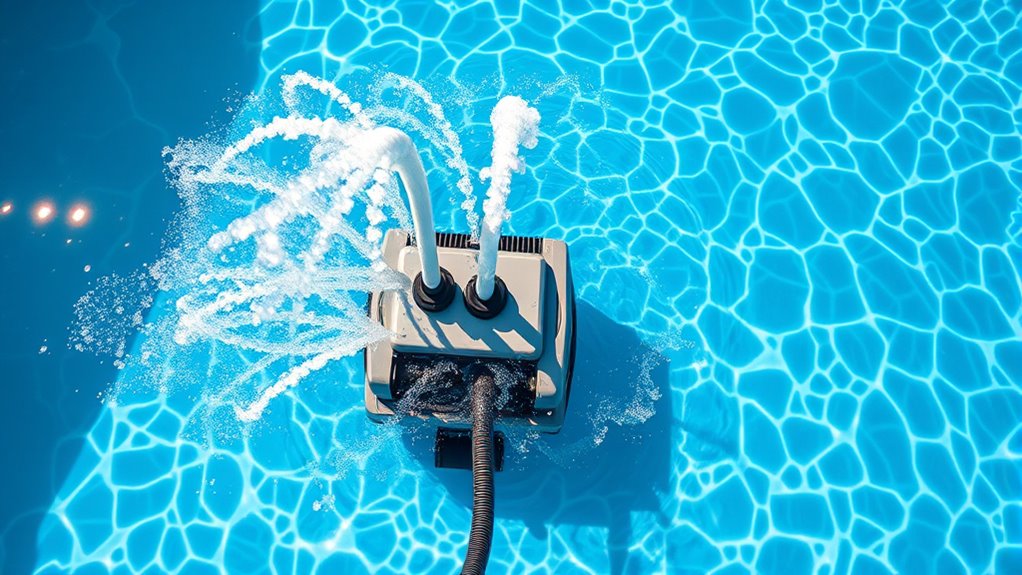
Water pressure is the driving force that moves your pool cleaner across the surface. It powers the suction mechanism, which pulls debris from your pool’s floor and walls. As water flows through the cleaner’s hose, it builds pressure that activates the motor operation inside the device. This motor then creates the suction necessary to lift dirt and debris into the cleaner’s filter bag. The more water pressure there is, the stronger the suction, making cleaning more efficient. Your pressure pool cleaner relies on this water pressure to operate smoothly without needing an external power source. By harnessing the flow of water, it effectively cleans your pool’s surfaces, saving you time and effort. This simple yet powerful process is what keeps your pool sparkling clean. Regular maintenance of your pool’s filtration system can also enhance cleaning performance, ensuring optimal water pressure for your cleaner. Proper water flow is essential for efficient pool cleaning, which is why understanding and maintaining pressure levels is crucial.
Navigation and Movement Mechanisms
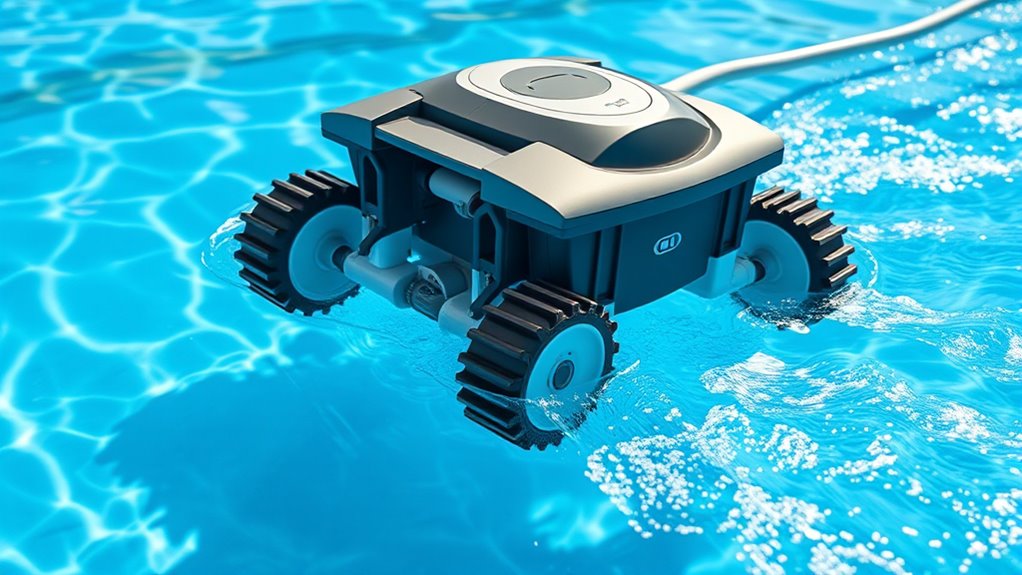
To effectively clean your pool, a pressure pool cleaner must navigate complex surfaces and obstacles. It uses robotic sensors to detect walls, steps, and tight corners, ensuring comprehensive coverage. Navigation algorithms process this sensor data to determine the best path. Picture these mechanisms in action:
- Sensors scanning the pool’s surface for obstacles
- Algorithms calculating the most efficient route around corners and ledges
- Motors adjusting movement direction based on real-time data
These components work together, allowing your cleaner to adapt to changing pool conditions. With robotic sensors guiding its movements and navigation algorithms making split-second decisions, the cleaner moves smoothly across the pool floor and walls, avoiding obstacles and covering every inch without manual intervention. Additionally, size and shape considerations play a role in how well the cleaner can maneuver through different pool designs. Recognizing the importance of tuning can help in optimizing the cleaner’s performance for different pool types and conditions. Moreover, advances in automation technology contribute to more intelligent and efficient cleaning cycles. For example, sensor calibration ensures accurate obstacle detection and optimal navigation, which is essential for maintaining consistent coverage across various pool environments.
Debris Collection and Filtration System
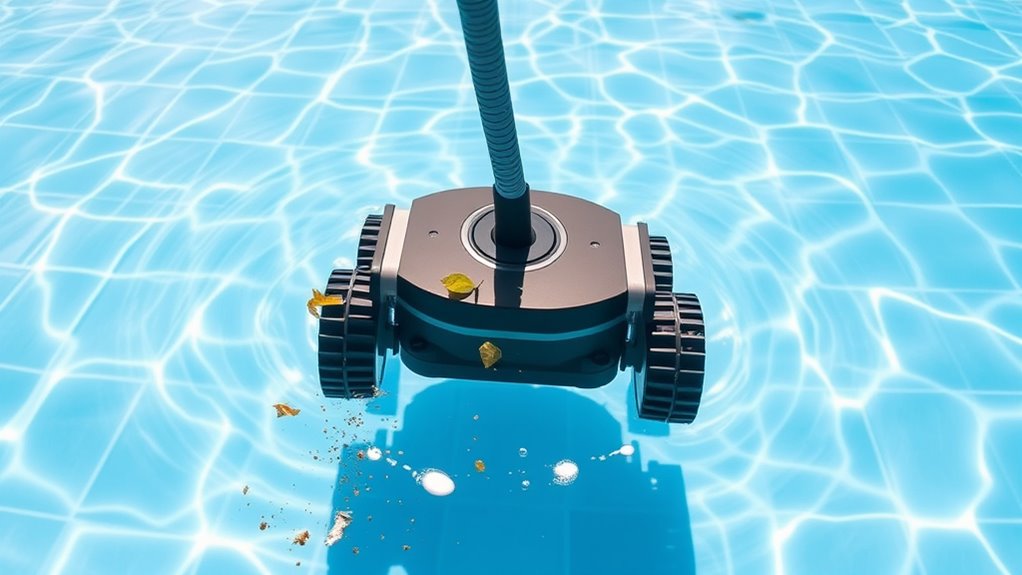
As your pool cleaner moves across surfaces, it actively collects debris like leaves, dirt, and insects, while its filtration system traps smaller particles and impurities. Maintaining proper pool chemical balance ensures the filtration works efficiently, preventing cloudiness and algae buildup. The debris basket or filter cartridge captures larger debris, which you can easily remove and clean. Fine filters handle smaller particles, keeping the water clear and inviting. If you use solar heating, the cleaner’s filtration supports ideal water quality, enhancing heating efficiency. Regularly cleaning the debris collection system prevents clogs and maintains suction power. This systematic debris collection and filtration process keeps your pool water pristine, reducing chemical use and prolonging equipment lifespan, ensuring a sparkling, healthy swimming environment.
Advantages and Considerations of Using Pressure Pool Cleaners
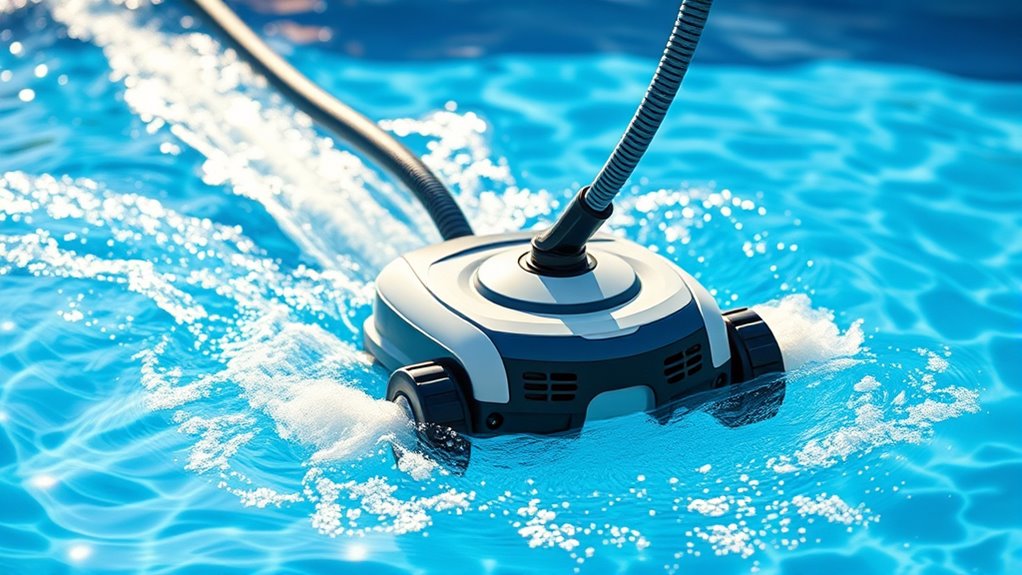
Pressure pool cleaners offer several advantages, making them a popular choice for many pool owners. They excel in covering large areas quickly, reaching tight spots, and handling heavy debris with ease. These cleaners are energy efficient because they use existing pressure from your pool’s pump, reducing extra power consumption. Additionally, they tend to have lower maintenance requirements since they have fewer moving parts and are built for durability. Imagine effortlessly sweeping away leaves from the deep end or scrubbing along the pool walls without hassle. Understanding store hours can help you plan your cleaning schedule to avoid peak times and ensure your pressure cleaner operates smoothly. However, consider that they may generate some noise and depend on your pool’s filtration system for ideal performance. Overall, pressure pool cleaners provide a reliable, efficient cleaning solution with minimal upkeep, making your pool maintenance simpler and more effective.
Frequently Asked Questions
Can Pressure Pool Cleaners Operate in All Pool Shapes and Sizes?
You might wonder if pressure pool cleaners can handle any pool shape or size. Generally, they work well in most pools, but their efficiency depends on your pool’s shape and size. Larger pools or complex shapes might require more coverage time or multiple passes. Check the cleaner’s specifications to confirm it’s suitable for your pool’s dimensions. With proper selection, you can keep any pool shape or size clean effortlessly.
How Often Should I Perform Maintenance on My Pressure Pool Cleaner?
You should perform maintenance on your pressure pool cleaner regularly to keep it functioning well. Follow a maintenance schedule, checking for debris, wear, and leaks weekly. Clean the filter and hoses as needed, especially after heavy use. Troubleshooting tips include inspecting for clogs or damage, ensuring proper water pressure, and replacing worn parts promptly. Staying consistent with maintenance helps prevent breakdowns and extends your cleaner’s lifespan.
Are Pressure Pool Cleaners Effective Against Algae and Stubborn Debris?
Think of your pressure pool cleaner as a vigilant guardian, tirelessly battling algae and stubborn debris. It’s effective in algae removal, sweeping away the green invaders, and debris removal, clearing leaves and dirt with precision. Its powerful jets and spinning brushes act like a whirlwind, ensuring your pool stays crystal clear. With consistent use, it keeps your pool sanitized, fresh, and inviting—making it an essential ally in your pool maintenance routine.
What Energy Costs Are Associated With Running a Pressure Pool Cleaner?
When considering the energy costs of running a pressure pool cleaner, you’ll find that energy consumption varies depending on the model and usage time. Generally, they consume less power than other pool cleaning options, helping keep operational costs manageable. By optimizing cleaning schedules and maintaining your equipment, you can further reduce energy expenses. Overall, pressure pool cleaners are an efficient choice, balancing effective cleaning with affordable energy consumption to lower your operational costs.
How Do Pressure Pool Cleaners Compare to Robotic or Suction Cleaners?
Did you know pressure pool cleaners cover up to 3,000 square feet per hour? Compared to robotic or suction cleaners, pressure models rely on manual operation and water pressure, making them more suitable for large pools. They typically have higher maintenance requirements and are less automated, but they’re effective for heavy debris. Robotic cleaners are more convenient, with less maintenance, while suction models are simple but may struggle with larger debris.
Conclusion
Now that you understand how pressure pool cleaners work, you see they’re more than just devices—they’re your pool’s loyal guardians. Their powerful water pressure and clever navigation keep your pool sparkling and inviting. Imagine the joy of stepping into crystal-clear water, free of debris, thanks to this reliable technology. With a pressure cleaner by your side, you’re not just maintaining a pool—you’re creating a haven of relaxation and happiness for everyone who swims.
